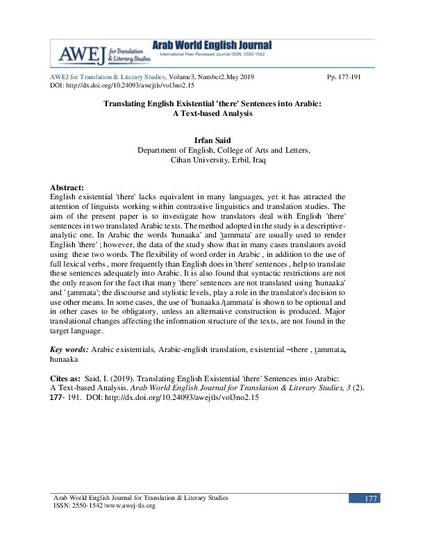
Article
Translating English Existential 'there' Sentences into Arabic: A Text-based Analysis
AWEJ for Translation & Literary Studies
(2019)
Abstract
English existential 'there' lacks equivalent in many languages, yet it has attracted the attention of linguists working within contrastive linguistics and translation studies. The aim of the present paper is to investigate how translators deal with English 'there' sentences in two translated Arabic texts. The method adopted in the study is a descriptive-analytic one. In Arabic the words 'hunaaka' and 'tammata' are usually used to render English 'there' ; however, the data of the study show that in many cases translators avoid using these two words. The flexibility of word order in Arabic , in addition to the use of full lexical verbs , more frequently than English does in 'there' sentences , help to translate these sentences adequately into Arabic. It is also found that syntactic restrictions are not the only reason for the fact that many 'there' sentences are not translated using 'hunaaka' and ' tammata'; the discourse and stylistic levels, play a role in the translator's decision to use other means. In some cases, the use of 'hunaaka /tammata' is shown to be optional and in other cases to be obligatory, unless an alternative construction is produced. Major translational changes affecting the information structure of the texts, are not found in the target language.
Keywords
- Arabic existentials,
- Arabic-english translation,
- existential –there,
- tammata,
- hunaaka
Disciplines
Publication Date
Spring May 15, 2019
DOI
http://dx.doi.org/10.24093/awejtls/vol3no2.15
Citation Information
Irfan Said. "Translating English Existential 'there' Sentences into Arabic: A Text-based Analysis" AWEJ for Translation & Literary Studies Vol. 3 Iss. 2 (2019) p. 177 - 191 ISSN: 2550-1542 Available at: http://works.bepress.com/awejfortranslation-literarystudies/147/